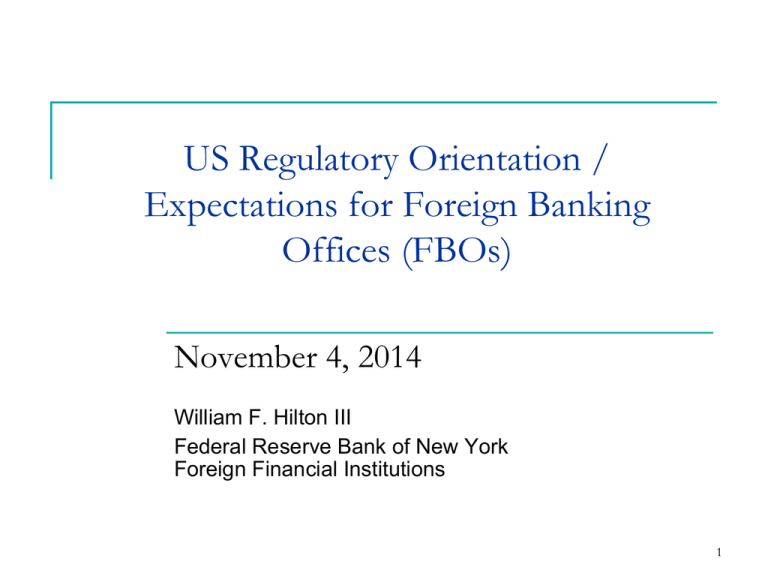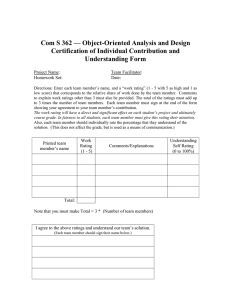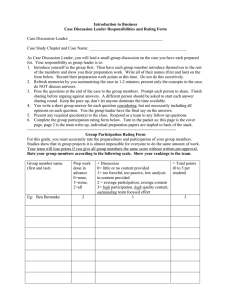William F. Hilton III
advertisement

US Regulatory Orientation / Expectations for Foreign Banking Offices (FBOs) November 4, 2014 William F. Hilton III Federal Reserve Bank of New York Foreign Financial Institutions 1 DISCUSSION POINTS n Vetting/Furnishing Examination Results n Consolidated Supervision n FBO Supervision Program n SOSA Ranking n RFI/C (D) Rating n CAMELS Rating 2 Vetting/Furnishing Examination Findings and Follow-up n n n n EICs gather memos, which include MRIAs and MRAs, from the on-site examiners and compose the report (Using recently issued SR 13-13 / CA 13-10) Findings are discussed in our offices Exit Meeting with FBO management, deliver report Rating and assessment provided to head office of each FBO, as well as either a q q n summary of condition of the FBO’s combined US operations, or SOSA notification letter (single-entity FBOs) Semiannual visitations/periodic meetings between examinations – CONTINUOUS MONITORING 3 COMMUNICATION OF SUPERVISORY FINDINGS n n n n SR Letter 13-13 (June 17, 2013) supersedes SR Letter 08-1 Discusses the Fed’s standard language to communicate exam findings, and improvements in the consistency and clarity of written communications to the supervised firms Discontinuation of using Observations as a separate category Reason: To better focus management’s attention on deficiencies noted during the examination 4 CONSOLIDATED SUPERVISION Primary objectives: n Specifies principal areas of focus for consolidated supervisory activities n Provides for consistent Fed supervisory practices and assessments Guidance SR 08-9 / CA 08-12 n Outlines Fed expectations for understanding and assessing key activities, risks, controls, nonbank subs n Reiterates coordination with and reliance on work of primary supervisors and functional regulators 5 CONSOLIDATED SUPERVISION (cont’d) Systematic Approach: n Develop assessments of consolidated BHCs and of combined US operations of FBOs through three principal processes: q Continuous monitoring activities, q Discovery reviews, and q Testing Why is this important? n Governance, infrastructure, risk management and internal controls must be sufficiently transparent for US supervisors to assess their adequacy 6 CONSOLIDATED SUPERVISION (cont’d) FBO US management’s role n Facilitate meetings with appropriate US ops personnel and supervisors’ requests for the following documents (particularly for US nonbank operations and material business lines): q Information used to assess inherent risks and internal control processes q Internal and external audit findings q MIS and reports on regulatory structure, strategy, operations, infrastructure 7 FBO SUPERVISION PROGRAM Risk-Focused supervisory framework for US operations of foreign banking organizations includes: n n n n Continuous Monitoring: Regulatory reporting and periodic visits/meetings ROCA Rating system for branches and agencies: Risk Management, Operational Controls, Compliance, Asset Quality Composite Rating: Based on ROCA component ratings SOSA: Strength-of-Support Assessment of the parent company Source: SR Letter 00-14 8 STRENGTH-OF-SUPPORT ASSESSMENT (SOSA) n n n n n Analysis starts with the financial profile and outlook of the FBO based on Fed-developed financial system overviews, country studies and accounting practice reports, as well as interviews & meetings, rating agency reports and public information. Assesses FBO’s ability to support US operations Places US operations in a larger context Aids risk focused exam process by highlighting FBOs warranting higher levels of supervisory attention Disclosed to Institution and Home Country Supervisor 9 SOSA RANKINGS n “1” = low risk that FBO will be unable to support its US Operations q q q q n “2” = more than normal review warranted q q q q n Non-investment grade At or below international capital standards Managerial oversight and support may be lacking in some respects Mitigating factor – home country support and supervision “3” = significant weaknesses apparent q q q q n Investment Grade Meets or exceeds international capital standards Ample access to US Dollar funding No concerns with home country support & supervision or transfer risk Seriously deficient financial profile (government/outside support maybe required) Lack of supervisory oversight and support Significant transfer risk FBO may be unable to honor US Obligations Ranking drives supervisory approach and risk-focused exam process 10 RFI/C (D) RATING SYSTEM n n n n n n n n R isk Management F inancial Condition I mpact C omposite D epository Institution Used for Bank Holding Companies Scale 1-5 See SR Letter 04-18 11 “R” RISK MANAGEMENT RATING Four subcomponent ratings of “R” I. Board and Senior Management Oversight II. Policies, Procedures, and Limits III. Risk Monitoring and Management Information Systems IV. Internal Controls 12 FINANCIAL CONDITION RATING n n n Evaluate the consolidated organization’s financial strength, inclusive of the Parent Company and nondepository institutions Focus on ability of the BHC’s resource to support the risks associated with its activities Evaluate and assign ratings to the four subcomponents of the “F” rating (Capital, Earnings, Asset Quality, Liquidity) 13 IMPACT RATING n n Assess impact of non-depository entities and parent on the depository institutions Evaluate both risk management/ controls and financial condition of the non-depository entities q n Do the non-depository entities provide services to depository institution? Are they critical services? Consider current and potential issues in overall assessment q Potential issues include: growth plans, new products/ services to both 3rd parties and related depository institution(s) 14 COMPOSITE RATING n n n Represents the overall assessment Encompasses both a forward-looking and static assessment of the consolidated BHC Reflects examiner judgment with regard to the relative importance of each RFI component (not an average) 15 DEPOSITORY INSTITUTIONS RATING n n n “D” rating stands outside of the composite rating Accept the primary/functional regulator’s CAMELS rating Multi-bank holding company where there are different ratings? è Weighted average of composite ratings scheme, but ambiguous 16 “CAMELS” RATING SYSTEM n n n n n n n n n C apital Adequacy A sset Quality M anagement E arnings L iquidity S ensitivity to Market Risks We also assign a Composite Rating Used for Financial Institutions Scale 1-5 17 HELPFUL TIPS n n n n Confidentiality of information and our reports Examination ratings are not negotiated, but rather vetted in our offices for consistency Examiners expect management to resolve problems and issues – ideally within prescribed timeframes for exam issues, and prior to the next examination for self-identified issues Ask rather than guess 18 RESOURCES n FOR Manuals: www.federalreserve.gov/boarddocs/supmanual/ n FOR SR Letters: www.federalreserve.gov/boarddocs/srletters n FOR BSA/AML: www.ffiec.gov/bsa_aml_infobase/default.htm Questions? 19

